Celebrate International Dark Sky Week! Participate in this weekend's activities and find out what you can do to keep the skies dark — the themes are "Stars Are Our Heritage" (Saturday) and "Take Action!" (Sunday).
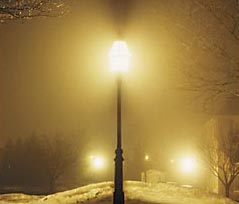
Lighting up the night has become a way of life. Our round-the-clock society demands that outdoor spaces be lit up for safety and security. But bigger and brighter lights do not equate with a safer nighttime environment — good lighting design is the key.
S&T: J. Kelly Beatty
Like death and taxes, there’s no denying that outdoor lighting has become an inescapable part of life. Streetlights adorn our roads, billboards stud our freeways, shopping-center parking lots are aglow from dusk to dawn, businesses obsess over late-night security, and convenience stores outdazzle one another to compete for customers. We cheat the night of darkness and, in the process, create light pollution that robs the sky of stars.
Electric streetlights have been with us since the 1880s, and it wasn’t long thereafter that some manufacturers recognized the visual and cost-saving benefits of directing light down, onto the ground. In 1918 the Holophane Glass Co. published the very first roadway-lighting manual. Titled The New Era in Street Lighting, it set forth a number of recommended practices, among them the common-sense notion that “Light above the horizontal must be conserved.” In a later section, the manual notes:
In addition to the two fundamental items of highly efficient lamps and the effective use of the light, as discussed, it is very important to see to it that the street lighting system produces an effect which surrounds the eyes of those using the streets with conditions under which the eye is free to perform its functions properly. Any system which fails in this respect is extravagant — no matter how efficient the lamps nor how efficiently the light may be directed upon the street surfaces or objects. Glare serves seriously to reduce the discerning power of the eye.
Unfortunately, almost no one heeded this unsung champion of good lighting practices. Instead, artificial skyglow became markedly more obvious in the late 20th century with the widespread use of high-intensity fixtures utilizing mercury-vapor and high-pressure-sodium lamps, and with a societal shift that found more people on the streets at night — and at later hours — than ever before. As our nocturnal wanderings increased, so too did the need for ubiquitous nighttime illumination. Then decision-makers began to equate “more light” with “better safety and security,” even though objective proof of such a relationship did not exist.
Lighting and Crime
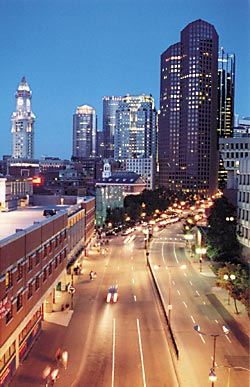
Artificial lighting has made it almost impossible to see a star-filled sky from urban environments.
Paul Lutkevich / IESNA
In 1996, at the request of Congress, the National Institute of Justice conducted a landmark assessment of crime and violence in the United States and published the results as Preventing Crime: What Works, What Doesn’t, What’s Promising. The study found little research to support “brighter-is-safer” approaches and even suggested that in some circumstances poorly designed illumination might actually increase personal vulnerability:
The problematic relationship between lighting and crime increases when one considers that offenders need lighting to detect potential targets and low-risk situations. Consider lighting at outside ATM machines, for example. An ATM user might feel safer when the ATM and its immediate surrounding area are well lit. However, this same lighting makes the patron more visible to passing offenders. Whom the lighting serves is unclear.
Vision and safety are further compromised by glare, which results when a light source forces the eye to adapt to a brighter scene than is actually present. Lighting engineers make a distinction between discomfort glare, which may not necessarily affect visual performance, and disability glare, which does. (One example of the latter is what you experience at night from the “high-beam” headlights of an oncoming vehicle.)
In recent years the role of glare on visual performance has taken center stage in lighting research. Nowhere is this truer than within the ranks of the Illuminating Engineering Society of North America, which establishes standards and recommended practices followed by lighting designers and manufacturers. New studies on glare, task-specific lighting, and their environmental context are driving major revisions in the society’s approach to establishing recommendations. “There’s been a profound change in the IESNA,” says James Benya, a nationally recognized lighting professional, and pro-dark-sky principles now dominate the society’s deliberations over outdoor lighting.
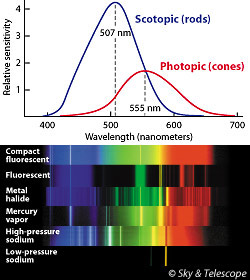
Cones in the human eye provide daytime (photopic) vision and perceive color. But they are far less sensitive to dim light than rods, which we use for nighttime (scotopic) vision. Modern sources of illumination vary greatly in efficiency and color. Note the poor match of high- and low-pressure sodium-vapor lights to the scotopic response curve, which peaks in blue-green light. A dim nighttime scene may require twice as many lumens of HPS light, or more, to equal the visibility of the “bluer” light emitted by a metal-halide bulb.
Gunter Wyszecki, W. S. Stiles, Dennis di Cicco, and J. Kelly Beatty
Color My World
One key area of research involves the eye’s spectral response and which bulb types are best for nighttime vision. Amateur astronomers, more than most, appreciate that we see differently during daylight than we do in darkness. The cones, which function only if exposed to luminance levels of at least 3 candelas per square meter, provide photopic (daytime) vision. Although they discern color, cones are most sensitive to yellow light, near 555 nanometers in wavelength. The rods, on the other hand, kick in when the luminance falls below 0.01 cd/m2, during scotopic (nighttime) vision. Rods detect brightness, not color, and are most sensitive to blue-green light, around 507 nm.
In deep twilight and under most outdoor-lighting situations, our eyes utilize a third range of vision, termed mesopic, for which the rods and cones work together to varying degrees. And it’s here, says researcher Ian Lewin (Lighting Sciences), that the situation gets complicated, because to the eye all lumens are not created equal. Various lamps emit light with distinctly different spectra, and not all are a good match to the scotopic sensitivity range. As the chart above shows, “white-light” sources such as metal-halide lamps produce most of their output in the scotopic range, whereas bulbs using high- and low-pressure sodium create yellowish spectra that the eye does not see as well in low-light situations.
For example, major roadways in North America typically are lit with an illuminance of no more than 1 lux, or 0.1 foot-candle — roughly 10 times that from the full Moon. To get the same level of scotopic response within the eye, HPS streetlights would need to be roughly one-third brighter — and LPS streetlights nearly twice as bright. A more critical benchmark may be a driver’s response time under varying streetlight sources. At the lighting levels typically found on side streets or in off-street surroundings, two to six times more HPS light is needed, compared to a metal-halide standard, to achieve equivalent response times.
New Directions in Streetlight Design
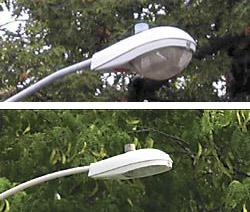
Most cities and towns in North America use streetlights with semi-cutoff optical assemblies (top) that beam some of their light directly up into the sky. When properly installed, full-cutoff fixtures (bottom) emit no light above horizontal.
S&T: Craig Michael Utter
An estimated 35 to 50 percent of all light pollution comes from streetlights, which typically are on every night from dusk until dawn and vary widely in design. Most streetlights have a rounded lens of plastic or glass below the lamp housing, the shape of which dictates how the beam is distributed onto the ground. Some have advanced optics to spread their light in specific, well-controlled directions, while others cast their output more indiscriminately — including up into the sky.
Streetlights termed full cutoff, which typically have flat bottoms or lenses, emit no light above horizontal, whereas cutoff fixtures more leniently allow 2½ percent of the light to shine per degree of angle at or above horizontal. The semi-cutoff classification, which allows even more upward-directed light, is the one most commonly used. Semi-cutoff “cobra-head” fixtures are easily recognized during the day by their deeply rounded refractive lenses and at night by the strong glare they cast into the eyes of drivers.

In a typical streetlight installation (top), semi-cutoff fixtures create broad cones of light that permit wide spacing between poles. But such fixtures create harsh glare and send some light directly into the sky. Full-cutoff fixtures reduce glare dramatically and eliminate direct uplight by sending all their light toward the ground (a). This efficiency should translate into lower bulb wattages if the existing poles are used. However, some lighting engineers argue that to achieve the same illumination uniformity as their semi-cutoff counterparts, full-cutoff fixtures need to be mounted either on taller poles (b) or closer together (c). This “glare versus uniformity” tradeoff has become a hotly debated issue. S&T illustration by Gregg Dinderman.
S&T: Gregg Dinderman
Although there’s no question that full-cutoff streetlights produce the least amount of glare and minimize light trespass (spillover) onto adjacent property, they are not necessarily roadway engineers’ fixtures of choice. “Sag-lens” or “drop-dish” fixtures with cutoff optics are now widely used. Their proponents, particularly the National Electrical Manufacturers Association, contend that using cutoff fixtures results in fewer streetlights, and thus less total reflection off the ground and less light pollution, than going solely with the flat-lens alternative espoused by dark-sky advocates.
Put another way, full-cutoff installations designed to meet current IESNA targets for light levels, uniformity, and glare might, in theory, use more electricity than, say, those using cutoff fixtures that produce more glare and uplight but whose light distribution below horizontal is well controlled. “This is very powerful stuff,” says Paul Lutkevich, former head of the IESNA’s Roadway Lighting Committee, and it suggests that the current classification system could be improved upon. To that end, Lutkevich says, the IESNA has formed a committee to come up with a new method of classifying fixtures with regard to light trespass, skyglow, and glare.
New Standards Needed
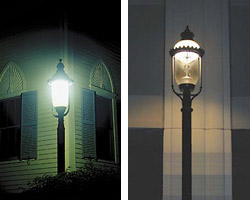
Many municipal officials are rushing to replace their streetlights with decorative, antique-looking fixtures. But 19th-century streetlights were never equipped with the high-intensity bulbs available today. As a result, most of these “period” fixtures create extremely harsh light (left), though full-cutoff designs are available that tuck the bulb out of direct view (right).
Courtesy J. Kelly Beatty and Ron Lahner (Penn. Globe Gaslight)
Meanwhile, there’s talk that the current illumination standards themselves need revision. For example, by reducing glare, roadway designers may be able to lower the illuminance levels produced by their streetlights. Recent research has focused on what is termed “small-target visibility,” or STV — how well drivers can spot, and react to, distant objects on or along the roadway — and the presence of glare factors heavily in such assessments. Preliminary assessments suggest that pavement doesn’t need to be nearly as bright when STV-based criteria for visibility are used.
Notably, officials in Calgary, Alberta, recently found that retrofitting their semi-cutoff streetlights with full-cutoff fixtures greatly increased illumination levels on the ground below — so much so that they are halving the wattage of the bulbs, a move that will save $1.4 million annually in energy costs. City officials add that the electricity they’re saving will reduce emissions of carbon dioxide from coal-burning power plants by more than 300 kilograms per fixture each year.
A growing trend in many towns and cities is to renovate their main thoroughfares with decorative lighting that harks back to the gaslight days of the past. Unfortunately, “period” fixtures that look attractive by day may be harsh sources of light at night, all too often blinding pedestrians and drivers alike with glary bulbs. However, many lighting manufacturers now carry product lines that house the bulb inside the fixture’s cap or utilize internal louvers that direct light downward — thus creating an aesthetic, low-glare compromise that satisfies both municipal planners and light-pollution activists.
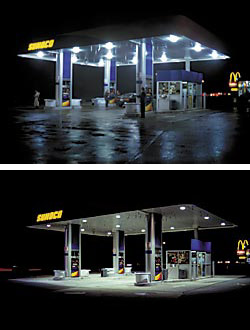
A recent study found that when the lighting under a service-station canopy was switched from high-glare fixtures (top) to those with full-cutoff optics (bottom), the percentage of drivers turning into the station — and the volume of gasoline sold daily — increased immediately. This suggests that drivers find good-quality lighting more appealing.
Courtesy Rensselaer Polytechnic Institute
Retail Lighting Wars
While the design of roadway lighting involves common sense and a scientific approach, that logic does not generally apply to retail establishments — especially those that cater to a late-night clientele. “A brightness war has broken out between gas stations throughout America,” observe Peter R. Boyce (Lighting Research Center) and two colleagues in a recent study. They find that if one station installs bright lights, competing stations feel obliged to be brighter still, and as a consequence illumination levels of 1,000 lux (100 foot-candles) — more than double that used in many indoor offices — have become common.
In this environment, retailers who try to hold the line by adhering to IESNA recommended practices perceive themselves to be at a competitive disadvantage. That’s true, for example, of the Home Depot, whose stores have parking lots illuminated at 10 lux (1 foot-candle) on average. But Lowe’s Home Improvement, a rival hardware chain, typically uses exterior lighting five times brighter as part of a campaign to make its stores appear more female friendly.
Lighting engineers now realize that the false daylight from overlit businesses creates unanticipated hazards. Our eyes need time to adapt to different levels of lighting; the more drastic the difference (or the older the person), the more time this adaptation takes. When people leave a brightly lit gas station or fast-food restaurant, their eyes can’t adjust quickly to the sudden darkness out on the street — and they sometimes forget to turn on their vehicle headlights.
In many cases, the brilliant floodlights used to illuminate commercial buildings and parking lots cast their light at such shallow angles that the visual grief from glare may outweigh the potential benefits of illumination. Worst among these are the so-called wallpacks, inexpensive boxlike fixtures on building exteriors that shine most of their light sideways instead of down.
Unfortunately, the terrorist attacks of September 11, 2001, have only fueled the desire for more security lighting. Yet a study recently conducted for the California Energy Commission found that lighting levels have no correlation with a person’s perception of safety. In fact, the energy crisis that brought California to the brink of financial chaos in 2001 has served as a wake-up call to state officials and businesses alike. Spurred by a gubernatorial decree, retail lighting was put under curfew. Many business owners found themselves saving significant sums of money when their existing dusk-to-dawn security lights were equipped with timers or replaced with motion-sensing fixtures.
Future Prospects
There is hope yet for starry skies. To date eight states (most recently Massachusetts) have passed laws that restrict outdoor lighting. A growing number of local ordinances have also been approved, though they vary widely in scope. Some require only that new or replacement municipally owned fixtures be full cutoff; others prohibit inefficient mercury-vapor lamps or mandate that all businesses and public buildings turn off unnecessary lighting after 11 p.m. unless they are open to the public. Stricter regulations occur in areas such as Arizona and Southern California, where there are many astronomical observatories. Some local regulations even apply to residential lighting.
Manufacturers and retailers are beginning to recognize the trend in lighting legislation, because in many locales stores must now carry only approved fixtures. New commercial developments now frequently employ full-cutoff lighting for parking lots — and some employ late-night timers — in an effort to keep their energy costs in check.
The overarching problem, explains engineer Benya, is that there are an estimated 10,000 lighting laws in the U.S., which range from “excellent to disaster,” and these existing lighting laws are often challenging to enforce. Moreover, there is no universal set of manufacturing specifications for lighting fixtures. The goal, he says, is to come up with standards, akin to the national codes followed by electrical contractors, that place limits on illumination levels, control levels of glare, and are backed by a common set of scientific standards. One idea gaining acceptance is the concept of tailoring lighting levels locally to one of four environmental zones ranging from “intrinsically dark” to “urban.” A single set of regulations is needed, Benya maintains, because “99 percent of the lighting that’s now installed isn’t designed — it just happens.”
 0
0
Comments
You must be logged in to post a comment.